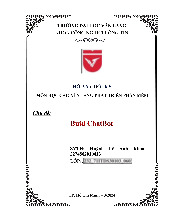









Preview text:
TRƯỜNG ĐẠI HỌC VĂN LANG
KHOA CÔNG NGHỆ THÔNG TIN ĐỒ ÁN CUỐI KỲ MÔN HỌC:
CÁC NỀN TẢNG PHÁT TRIỂN PHẦN MỀM Chủ đề: CASE STUDY NHÓM: 18 SVTH: HỌ TÊN SV – MSSV
Trần Ngô Thuý Vy ; 2274802011037
Nguyễn Thanh Tùng : 2274802010976
Trần Thanh Tùng : 2274802010978 LỚP: 232_71ITDS30103_01 GVHD: NGUYỄN GIA HƯNG
TP. Hồ Chí Minh – 3/2024
BẢNG PHÂN CÔNG TRONG NHÓM _18_ STT HỌ TÊN SINH VIÊN CÔNG VIỆC GHI CHÚ 1 Trần Ngô Thuý Vy PowerPoint 100% 2 Nguyễn Thanh Tùng Tìm nội dung 100% 3 Trần Thanh Tùng Sơ lược tóm tắt 100% 4
Trần Minh Thế Tuấn 0% 5 Ngô Trần Tường Vy 0% 1 INTRODUCTION
In the dynamic landscape of technology startups, the foundation of
success lies in a resilient and scalable infrastructure. This document
outlines a strategic architectural transformation tailored to address the
evolving needs of a hypothetical startup poised for rapid growth.
Initially reliant on a conventional LAMP stack, the startup's
infrastructure faces limitations in scalability, disaster recovery, and data
security. As the startup anticipates global expansion and heightened user
demands, these deficiencies become critical pain points.
Our proposed solution advocates for the adoption of Amazon Web
Services (AWS) to build a robust, scalable, and secure foundation. By
leveraging AWS's elastic services, the startup can seamlessly
accommodate growth, ensure disaster recovery readiness, and fortify data security.
Through meticulous planning and phased migration to AWS, the
startup can mitigate disruptions, empower staff with AWS expertise, and
ensure ongoing optimization and compliance. Deliverables
CHƯƠNG 1: CURRENT ARCHITECTURE
1. Current Architecture:
- Utilizes a LAMP stack comprising MySQL, Apache, and PHP on a single desktop PC.
- Lacks Disaster Recovery provisions.
- Absence of configuration for optimizing performance and throughput. 2
- Inefficient load distribution and absence of self-healing infrastructure.
- Concerns regarding data security.
- Limited access control capabilities.
- No archival strategy for inactive objects.
- No mechanism for environment replication. 2. Data Gathered:
- Anticipates significant, rapid growth in the startup.
- Worried about potentially over or under provisioning infrastructure.
- Emphasis on low latency user experience globally.
- Requirement for high availability and fault tolerance.
- Critical importance of data security and access control.
- Desire for efficient management and scalability. 3. Assumptions:
- Unpredictable growth in the anticipated user base.
- Global user distribution prioritizing low latency.
- Resource constraints within the startup's small office.
- Limited expertise in managing cloud infrastructure.
- Budget constraints but willingness to invest strategically. CHƯƠNG 2: PAIN POINT 1. Current Pain Point 3
- Uncertain scalability leading to potential under or over provisioning.
- Lack of Disaster Recovery capability.
- Performance and latency issues, especially for distant users.
- Manual load distribution and absence of self-healing mechanisms.
- Vulnerabilities in data security and access control.
- No archival strategy for long-term data storage.
- Limited ability to replicate environments.
2. Technical Requirements with Assumptions:
- Scalability: Architecture must handle unpredictable growth.
- Disaster Recovery: Provision for data backup and recovery.
- Performance: Low latency, high throughput globally.
- Fault Tolerance: Self-healing infrastructure for service continuity.
- Security: Data encryption, access control mechanisms.
- Archival: Strategy for long-term data storage.
- Environment Replication: Easily deployable and manageable environments.
3. Functional Requirements:
- Load Distribution: Efficient routing of traffic.
- Self-healing Infrastructure: Automatic recovery from failures.
- Data Security: Encryption at rest and in transit.
- Access Control: Granular control over resource access.
- Archival Strategy: Management of long-term data storage. 4
- Environment Replication: Easy deployment and management of environments.
CHƯƠNG 3: PROPOSED SOLUTIONS 1. Proposed Solutions: - Target Architecture Diagram. - Solutions Building Blocks.
- Scalability & Elasticity: Utilization of AWS services such as EC2 Auto
Scaling, RDS Aurora for database scalability, and DynamoDB for NoSQL scalability.
- Disaster Recovery: Implementation of automated backups using AWS
Backup, Route 53 for DNS failover, and CloudFormation for infrastructure as code.
- Performance & Latency Optimization: Employment of CloudFront for
global content delivery, ElastiCache for caching, and RDS Read
Replicas for distributed data access.
- Load Distribution: Use of ELB (Elastic Load Balancing) for efficient
traffic distribution across instances.
- Self-healing Infrastructure: Implementation of AWS Lambda for
serverless computing and AWS Auto Scaling for automatic resource provisioning.
- Security: Utilization of AWS Key Management Service (KMS) for data
encryption, AWS Certificate Manager (ACM) for SSL certificates, and IAM for access control. 5
- Access Control: Setting up VPN with AWS VPC, Bastion Host for
secure access, Security Groups, and Network Access Control Lists
(NACLs) for fine-grained control.
- Archival Strategy: Implementation of lifecycle policies in S3 for object
archival to Glacier for inactive objects.
- Environment Replication: Utilization of AWS CloudFormation or CDK
for infrastructure as code to easily replicate environments.
2. Detailed Explanation:
- Scalability: AWS services provide on-demand scalability, ensuring resources match demand.
- Disaster Recovery: Automated backups and failover mechanisms
ensure data integrity and service continuity.
- Performance: Content delivery optimization and distributed data access minimize latency.
- Load Distribution: ELB efficiently distributes traffic across instances,
optimizing resource utilization.
- Self-healing Infrastructure: Automated scaling and serverless
computing ensure service recovery from failures.
- Security: Encryption, secure access mechanisms, and fine-grained
control mitigate security risks.
- Archival Strategy: Automated archival policies manage long-term data storage efficiently.
- Environment Replication: Infrastructure as code facilitates easy
replication and management of environments. 6 3. Migration to AWS:
- Evaluate current workload for compatibility with AWS services.
- Plan phased migration ensuring minimal disruption.
- Train staff on AWS services and best practices.
- Test and validate migrated components for functionality and performance.
4. Future Concerns when Migrating to AWS:
- Cost management and optimization.
- Monitoring and performance tuning.
- Compliance with regulatory requirements.
- Integration with third-party services.
- Continuous security updates and patches. 5. Next Phase:
- Implement phased migration to AWS.
- Monitor performance and optimize resource utilization.
- Continuously update security measures.
- Plan for further scalability and expansion.
CHƯƠNG CUỐI: CONCLUSION AND RECCOMMENDATIONS 7
In the journey of transforming the startup's infrastructure from a
simple local system to a robust, flexible, and secure system on the AWS
platform, we have achieved a range of important objectives.
Successful Summation:** By focusing on key factors such as
scalability, disaster recovery, performance, and data security, we have
designed a comprehensive and practical solution for the startup.
AWS Foundation: By transitioning to AWS, we have created a
flexible and scalable infrastructure built on a platform that is readily
available and validated by AWS, minimizing risks and increasing availability.
Migration Process: By implementing a phased migration
approach, we have ensured minimal disruption to operations while
maximizing the benefits of AWS services. We have also prioritized staff
training to empower them with the necessary skills for managing the new infrastructure effectively.
Moving forward, we recommend the following:
Continuous Monitoring and Optimization: Regular monitoring of
performance metrics and optimization of resources will be crucial to
ensuring the continued efficiency and effectiveness of the AWS infrastructure. 8
- **Investment in Training and Development:** Continued investment
in staff training and development will be necessary to keep pace with
evolving AWS technologies and best practices.
- **Exploration of Additional AWS Services:** As the startup grows
and its needs evolve, exploring additional AWS services and features can
further enhance efficiency, scalability, and security.
- **Regular Security Audits and Updates:** Conducting regular security
audits and staying up-to-date with security patches and updates will be
essential to safeguarding the infrastructure against emerging threats.
In conclusion, the transition to AWS has positioned the startup for long-
term success by providing a scalable, resilient, and secure foundation for
its operations. By embracing the recommendations outlined above, the
startup can continue to leverage the full potential of AWS and stay ahead
in today's competitive landscape. HẾT 9




